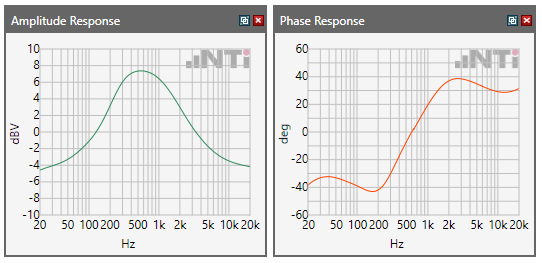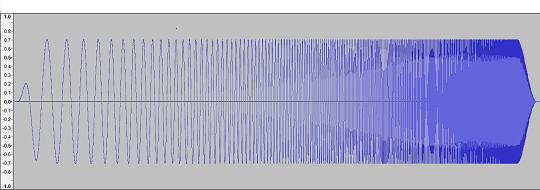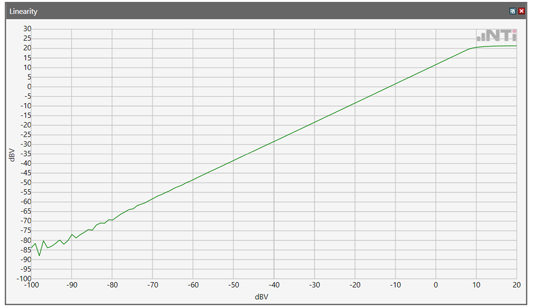When sweep measurements are plotted on a graph, the y-axis identifies the measurement results. The graph is named according to what is being measured appended with the word “response”. For example, results can be named as “amplitude response”, “impedance response” or “phase response”. An exception to this naming convention is the term “frequency response”. To be technically correct, the frequency response refers to both the amplitude and the phase response together. Be aware that it is, however, also common in practice that the frequency response refers to the amplitude response alone.

Frequency Response
The input signal could be varied across frequency or amplitude (x-axis). The convention is that, in the absence of further information, it may be assumed that frequency is used as the variable input for the x-axis.
The following section describes how the sweep input signal can vary and how these variations can be parameterized.
Glide Sweep
A glide sweep (or chirp) is a continuous signal in which the frequency increases or decreases logarithmically with time. This provides the complete range of testing frequencies between the start and stop frequency. An advantage over the stepped sweep is that the signal duration can be reduced by the user without any loss of frequency resolution in the results. This allows for rapid testing.
The impulse response of a device under test can be calculated from the measured results. From this the amplitude, phase, and distortion measurements are calculated. Unwanted acoustic reflections can be reduced using a time window.

Glide Sweep signal
Since the exact duration of the sweep signal is known, the glide sweep is ideally suited for measuring signals that are not played by the audio test system itself, rather by the device under test. To indicate to the measurement system that the test signal is about to start, the sweep signal is preceded by a short trigger sequence. This method is particularly useful when measuring devices which do not have an audio input channel, e.g. Smartphones, tablets or smart devices.
Although the theory behind the glide sweep has been known for several decades, its use in audio measuring devices has only evolved over the past several years. The reason for this lies with the high computing power required.
Stepped Sweep
In a stepped sweep, one variable input parameter (frequency or amplitude) is incremented or decremented in discrete steps. After each change, the analyzer waits until a stable reading is detected before switching to the next step. The scaling of the steps is linear or logarithmic. The stability condition (settling) can be defined by the user.
Since the settling time of different test objects cannot be predicted, the duration of a stepped sweep cannot be determined exactly in advance.
For the determination of amplitude or frequency response, the stepped sweep has been largely replaced by the glide sweep. The main application for the stepped sweep is to measure the linearity of systems. Here, the frequency of the test signal is kept constant while the amplitude is varied. Typically the amplitude and distortion of the device under test are measured. This is also referred to as an “amplitude sweep”.

Linearity measurement
Amplitude Weighting
With frequency selected as the variable input parameter, the amplitude profile of the input signal can be defined. For example, this allows for the equalization of an amplifier or loudspeaker so that a flat electrical or acoustic amplitude response is achieved as output. This method can be applied to both glide sweep and stepped sweep.
Time Sweep
In the case of a time sweep, the x-axis represents time. Again the y-axis represents a measured value, e.g. amplitude. The change in the measured value is observed over time. For example, how does the response of the device under test change over a long period?
Table Sweep
A rarely-used special form of the stepped sweep is the table sweep. Here the input signal is produced from a table as a sequence of any frequency and amplitude pairs.